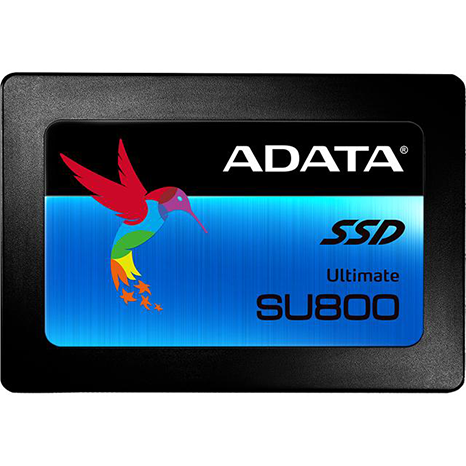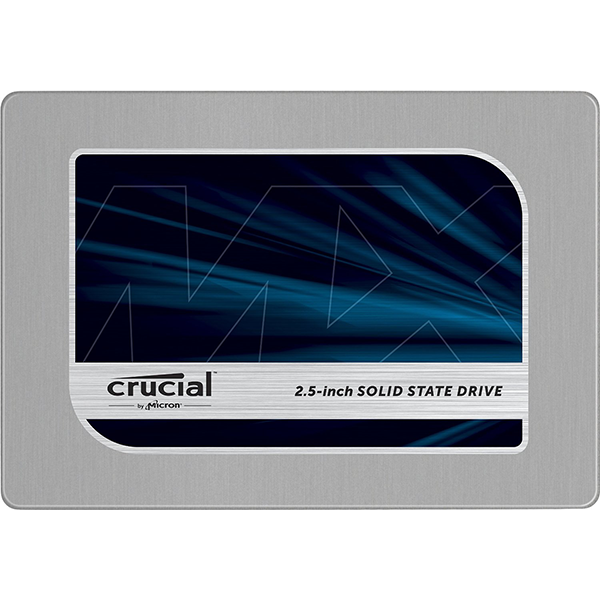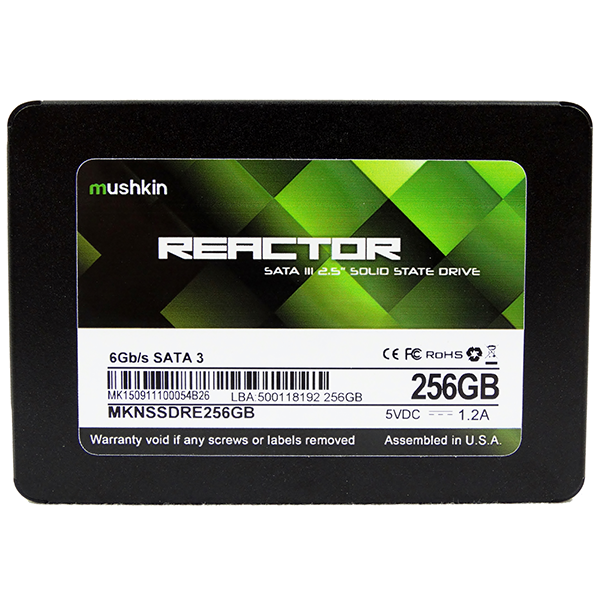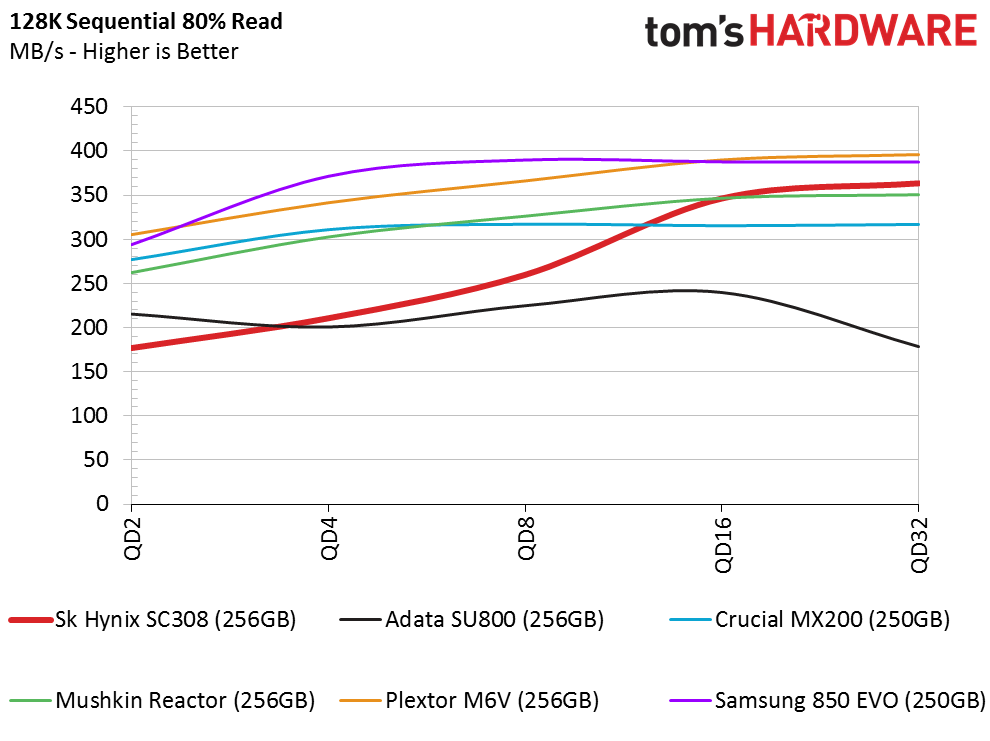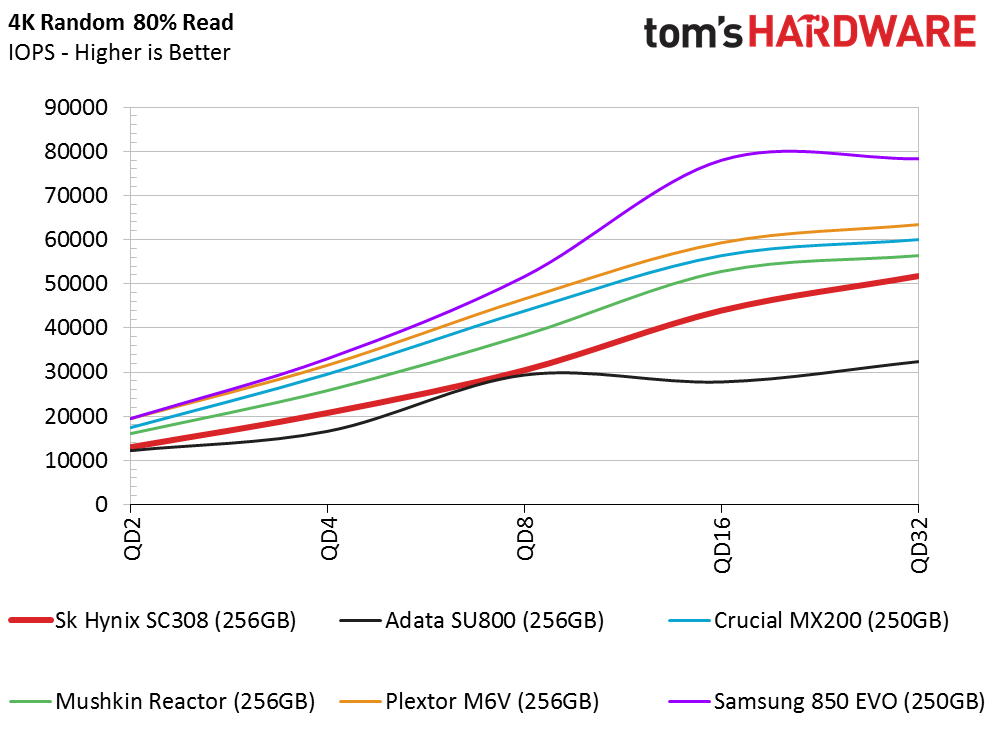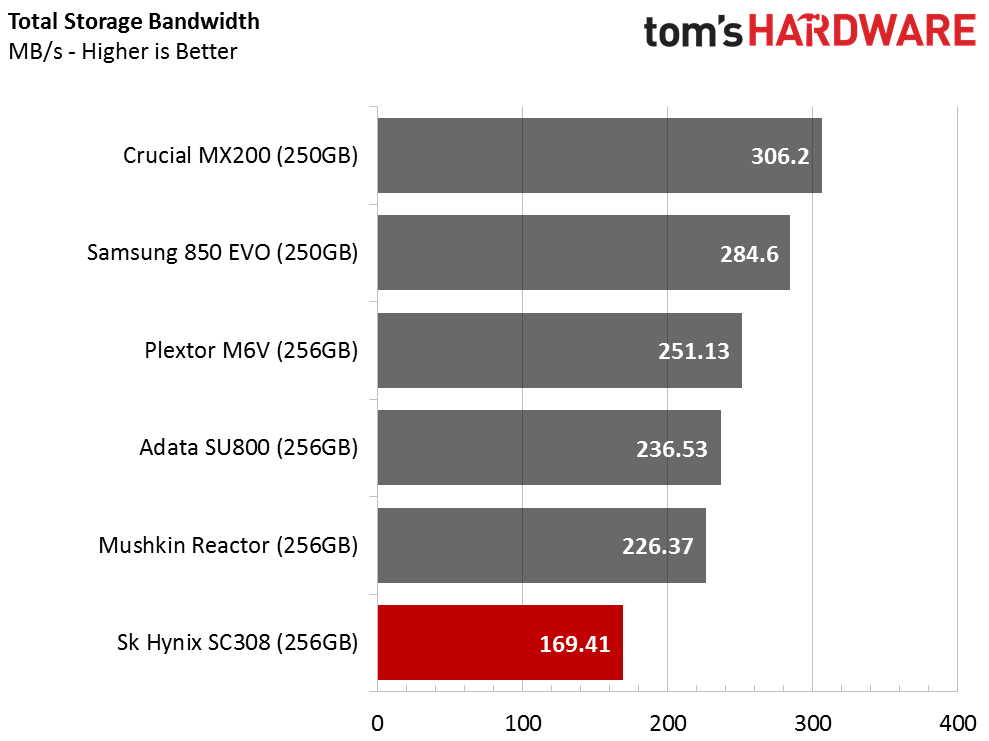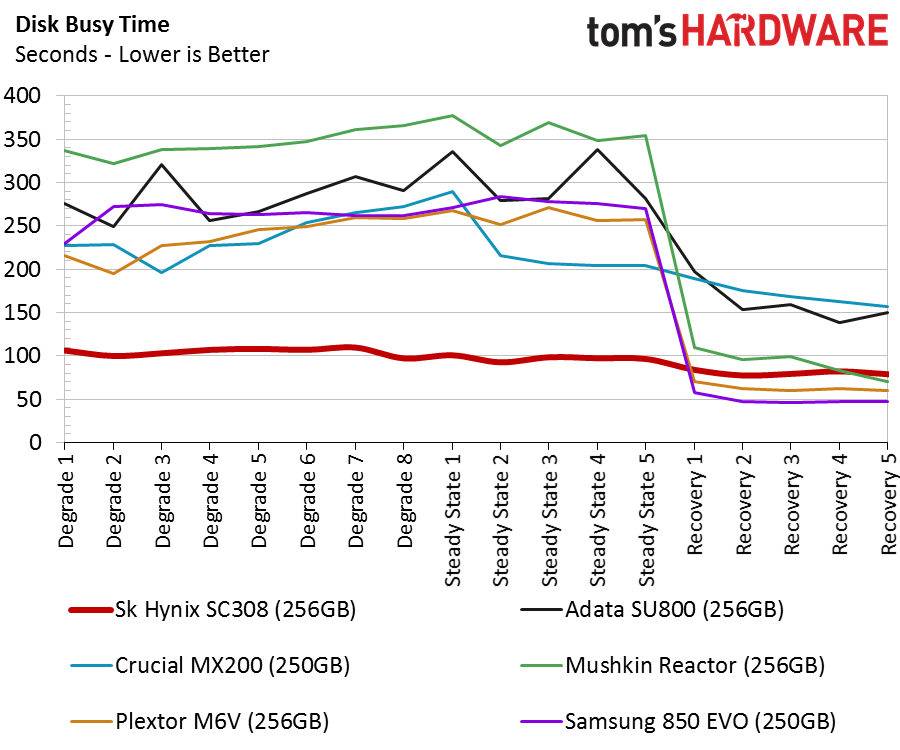SK Hynix SC308 SSD Review
Why you can trust Tom's Hardware
256GB Performance Testing
Comparison Products
You have to reset the clock with 256GB-class products. We had to dig deep into our archives to build these charts. Lithography advancements created higher-capacity NAND die, which in turn require fewer die to construct low-capacity SSDs. SSDs need to access more die at the same time to perform at high speeds, but dense NAND reduces performance because of less NAND parallelization. Due to clever engineering, the performance doesn't cut in half with half the number of die.
Companies don't like to send reviewers products that don't meet "up to" performance numbers. We often see the "up to" performance numbers on the main product page, but the vendors bury the real specifications in the fine print. The smaller drives suffer a significant performance drop off compared to the higher capacity models. If a company uses a single performance rating for a product series, it's often an "up to" specification. That means you need to investigate further. The vendors want to tuck this information away, so lately we don't receive many 256GB-class products.
The Adata Ultimate SU800 uses an SMI SM2258 controller with Micron 3D TLC NAND. It's one of the newest 256GB-class SSDs we've tested. The drive suffers from low performance when data fills the SLC cache. The SSD folds the data into TLC rather than use the newer direct-to-die method. We found the SU800 256GB for $99.99. The Crucial MX200 is an older SSD, but it still sells for $159.99. It's a popular choice for users still looking for MLC NAND, but its price has crept up over the last year. The Mushkin Reactor also features MLC flash and retails for $139.99. The Plextor M6V is available from a very limited number of retailers but has moved on from Amazon and Newegg. It features TLC flash and shows how products from early 2016 compare to newer hardware. Samsung discontinued the 850 EVO 250GB, but both Amazon and Newegg still have inventory. Expect to spend around $109.
Sequential Read Performance
To read about our storage tests in-depth, please check out How We Test HDDs And SSDs. We cover four-corner testing on page six of our How We Test guide.
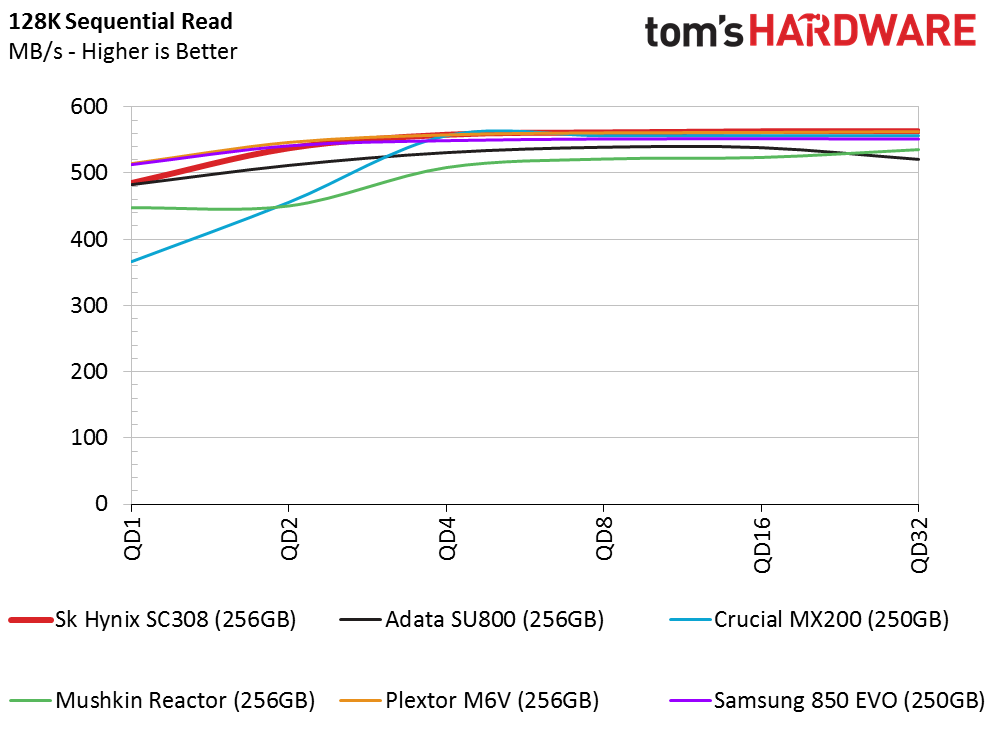
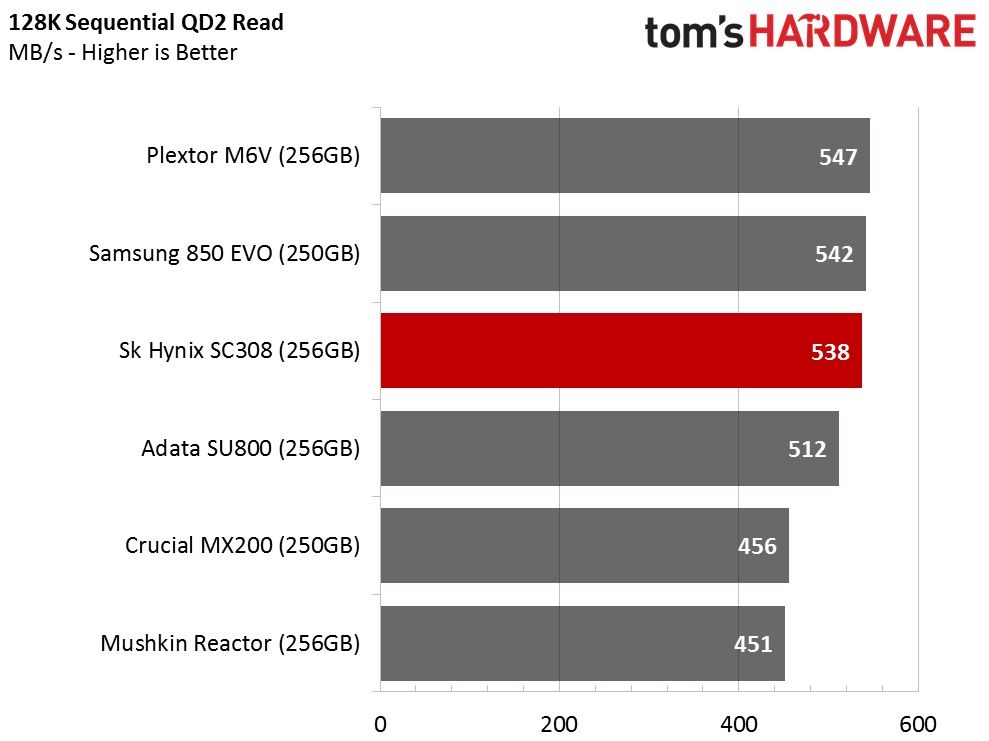
This product class delivers nearly identical sequential read performance compared to the 512GB-class SSDs we tested on the previous page. The SC308 256GB writes data within 1 MB/s of the larger model at QD2.
Sequential Write Performance
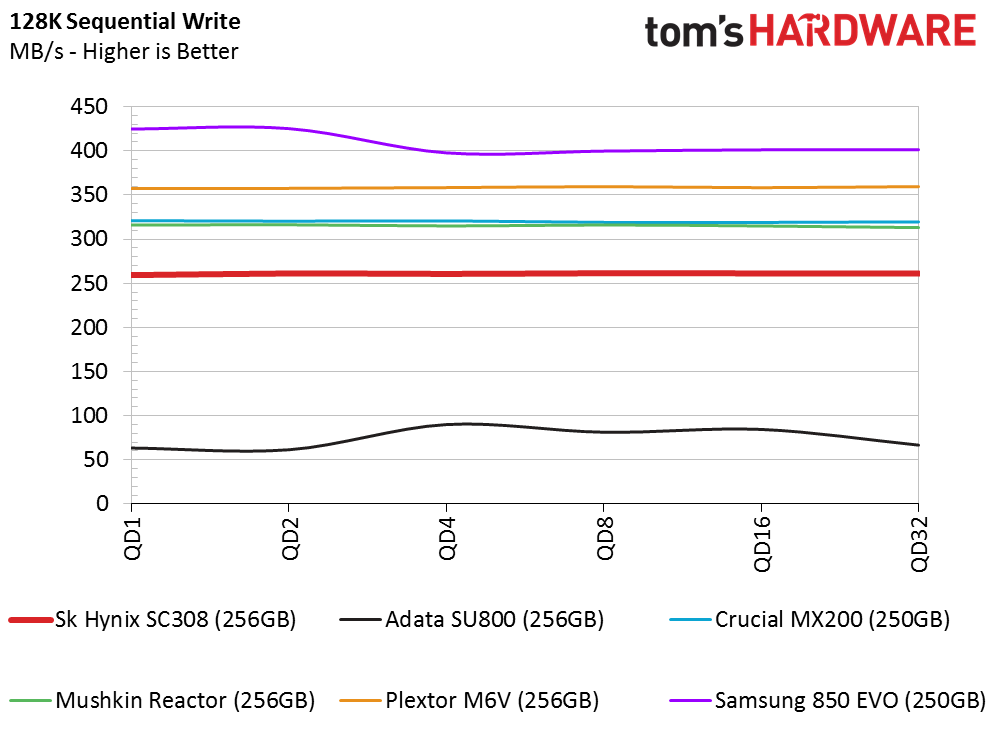
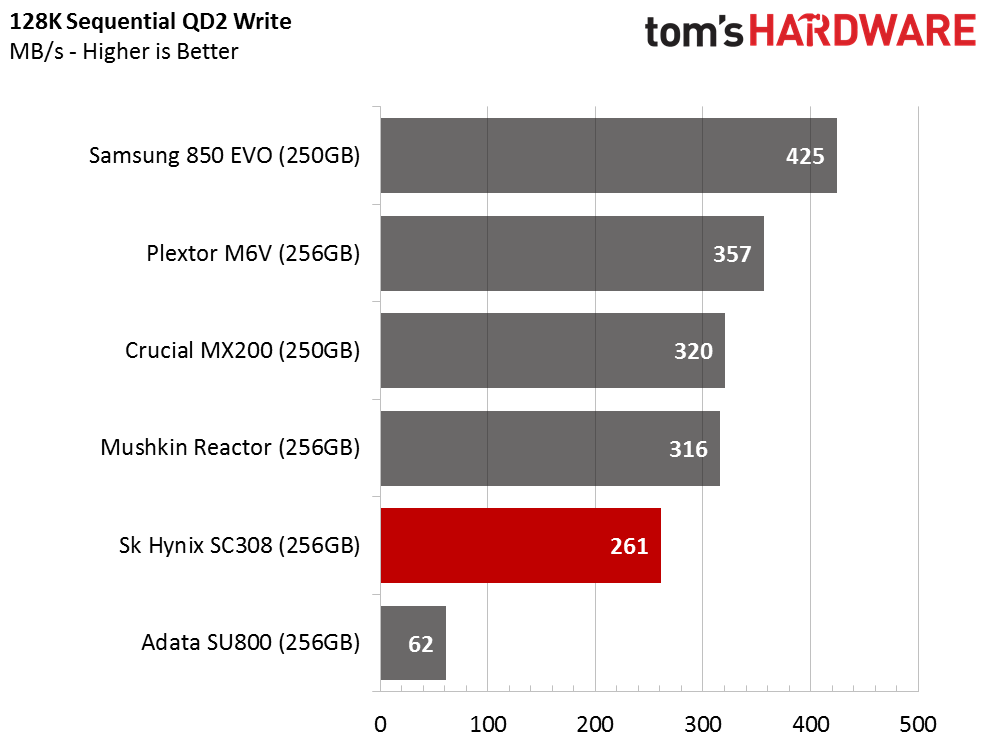
We see a lot of variation in sequential write performance. These drives all use distinct types of controllers, flash, and IP. The SK Hynix SC308 isn't as fast as the older products, but it is much better than the SU800 with 3D TLC.
Random Read Performance
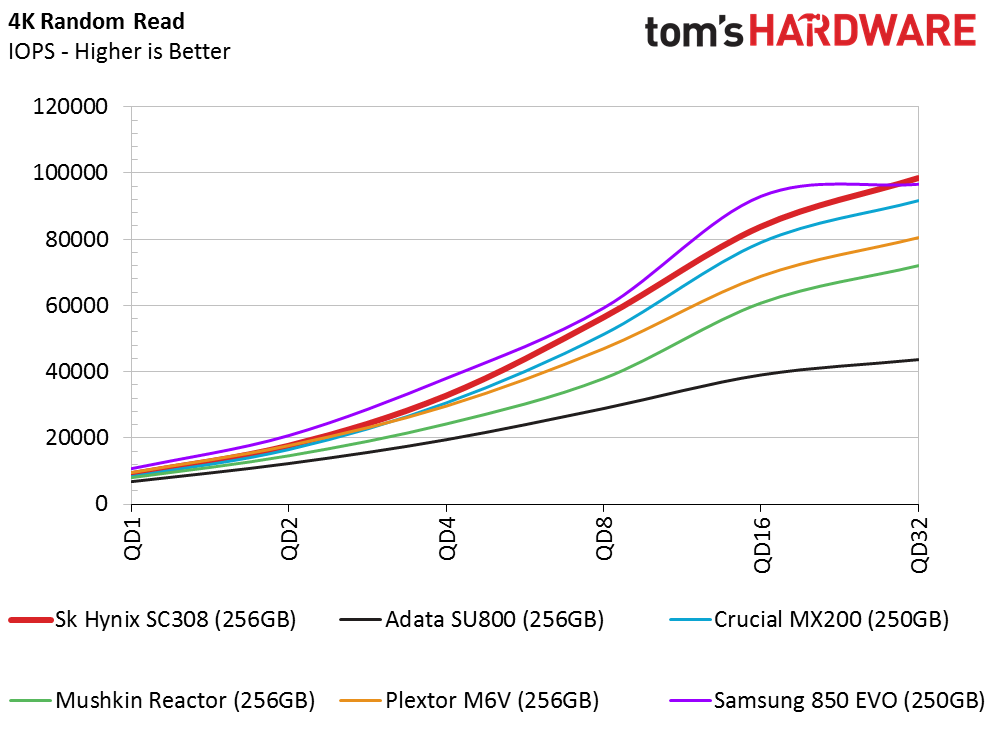
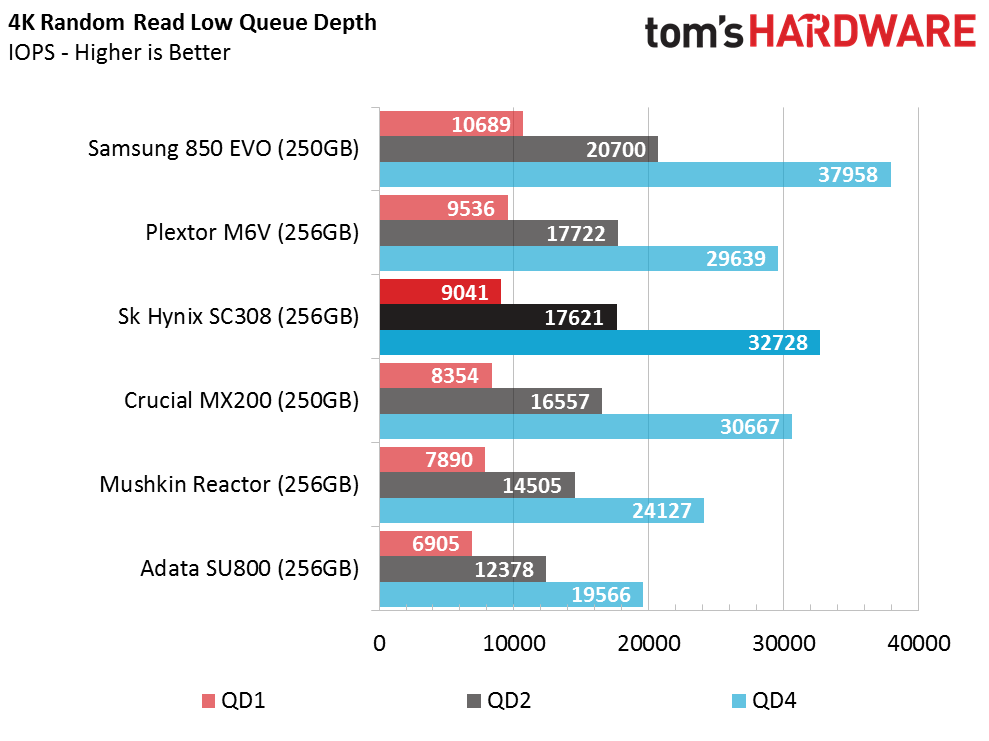
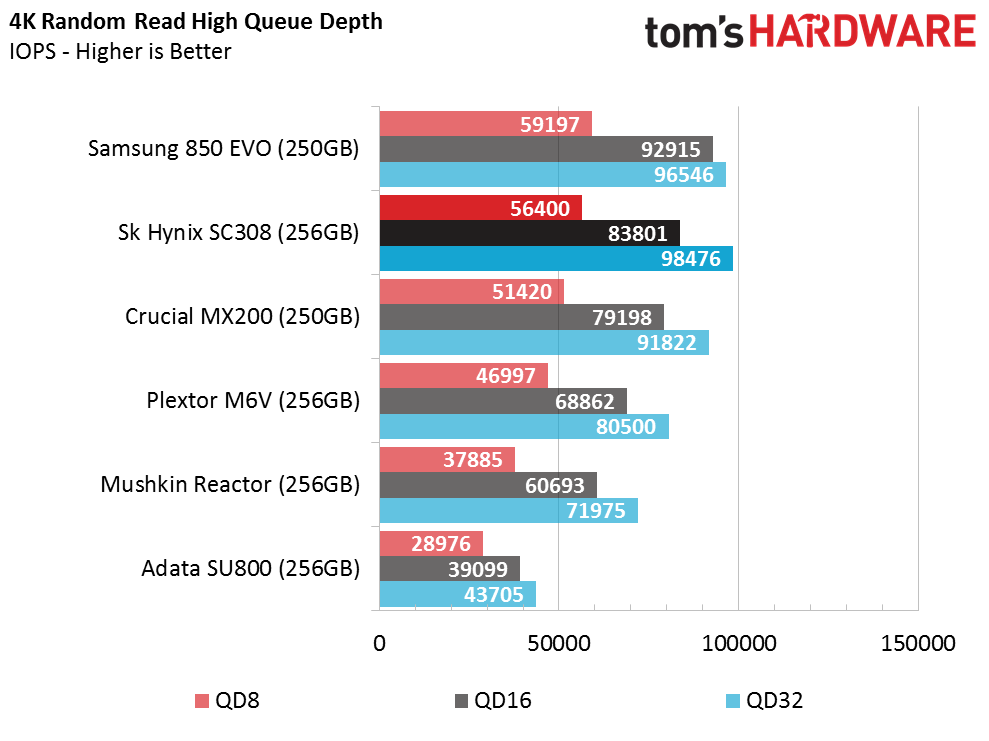
We've discussed SSD performance regression for over a year, but the SK Hynix SC308 doesn't suffer from "progress." SK Hynix has 3D flash, but the company hasn't brought the new media to consumer SSDs because the large die is better suited for high capacity drives. Hynix manufactures NAND, so it still has access to planar flash.
Get Tom's Hardware's best news and in-depth reviews, straight to your inbox.
Random Write Performance
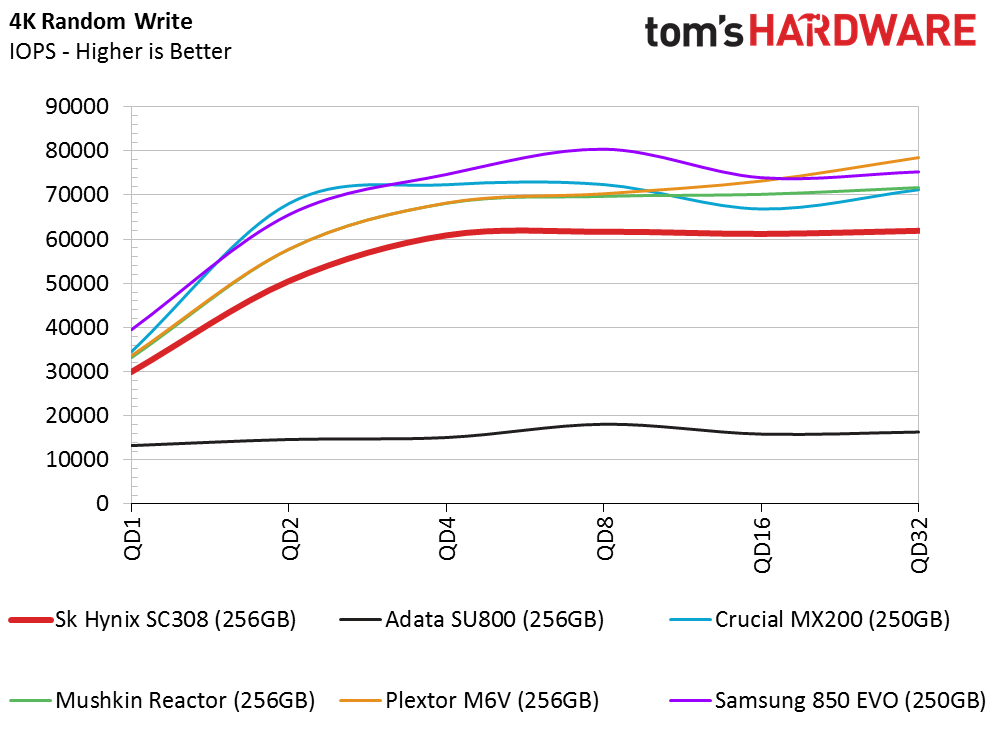
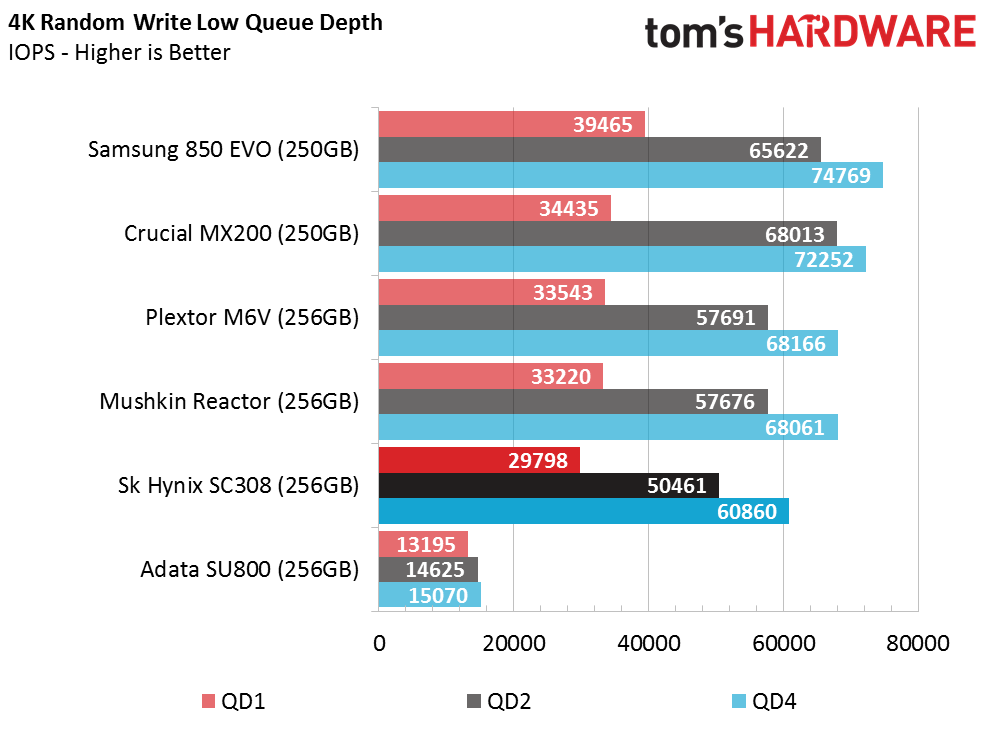
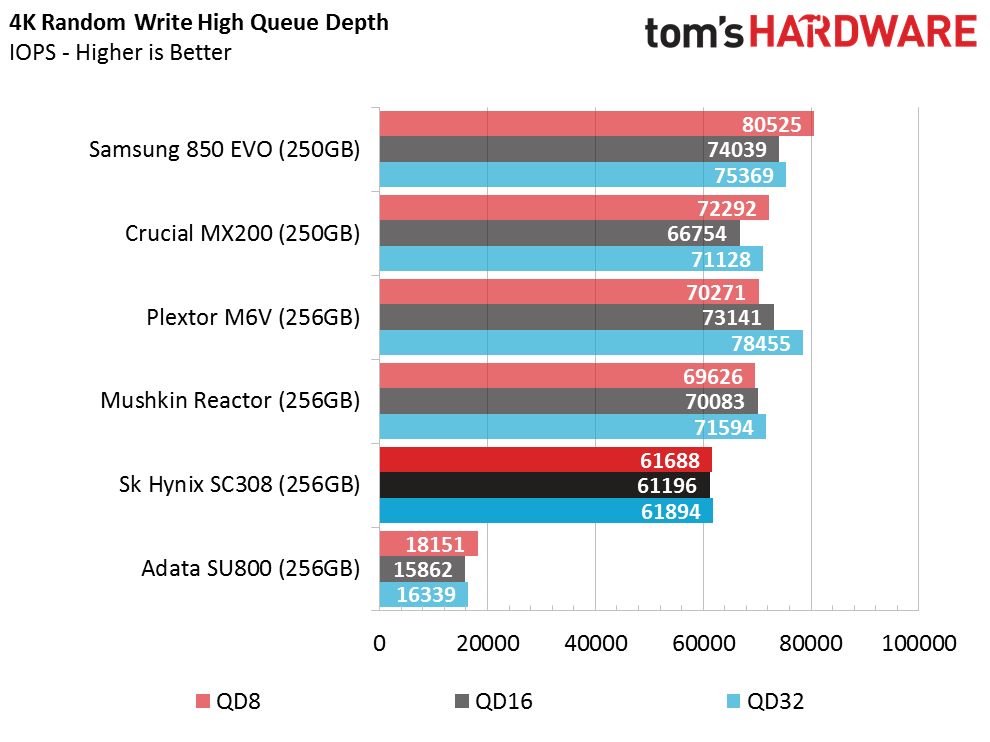
The SC308 256GB has lower random write performance than the older products, but it still outperforms the Micron 3D NAND in the SU800.
80 Percent Mixed Sequential Workload
We describe our mixed workload testing in detail here and describe our steady state tests here.
Like the 512GB model, the 256GB SC308 doesn't perform well with mixed workloads. At QD2, the SC308 delivers the least bandwidth. Performance increases as the workload intensifies, but it still trails well behind some of the other products.
80 Percent Mixed Random Workload
The SC308's mixed random performance is also lower than many of the other drives. Like before, this will tip back up in the next section with real-world applications.
PCMark 8 Real-World Software Performance
For details on our real-world software performance testing, please click here.
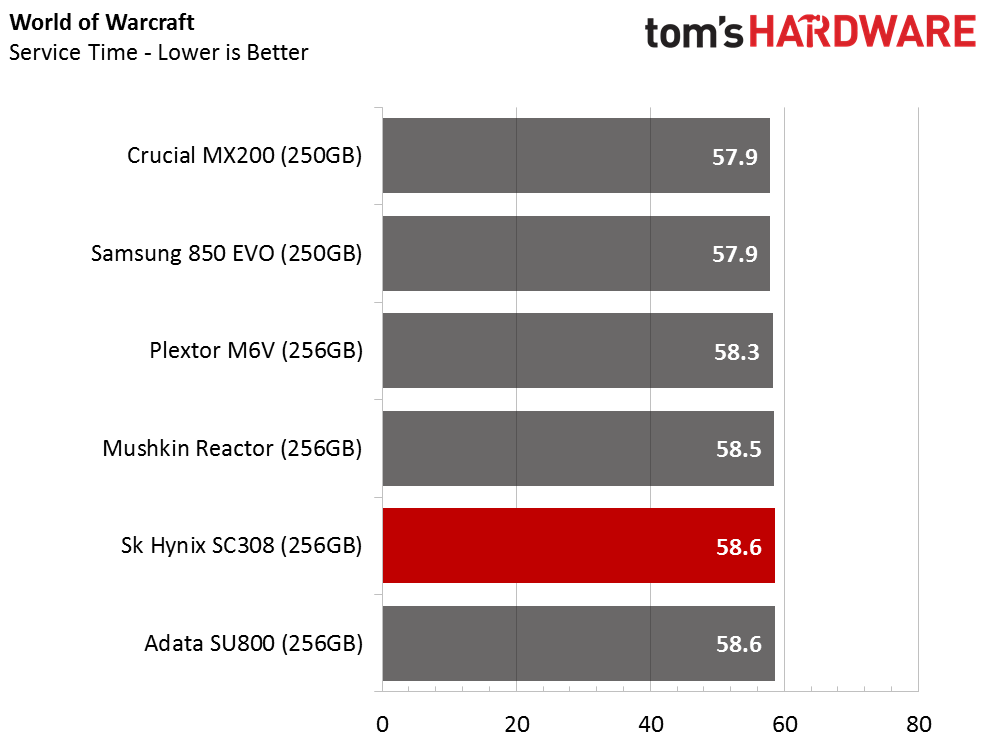
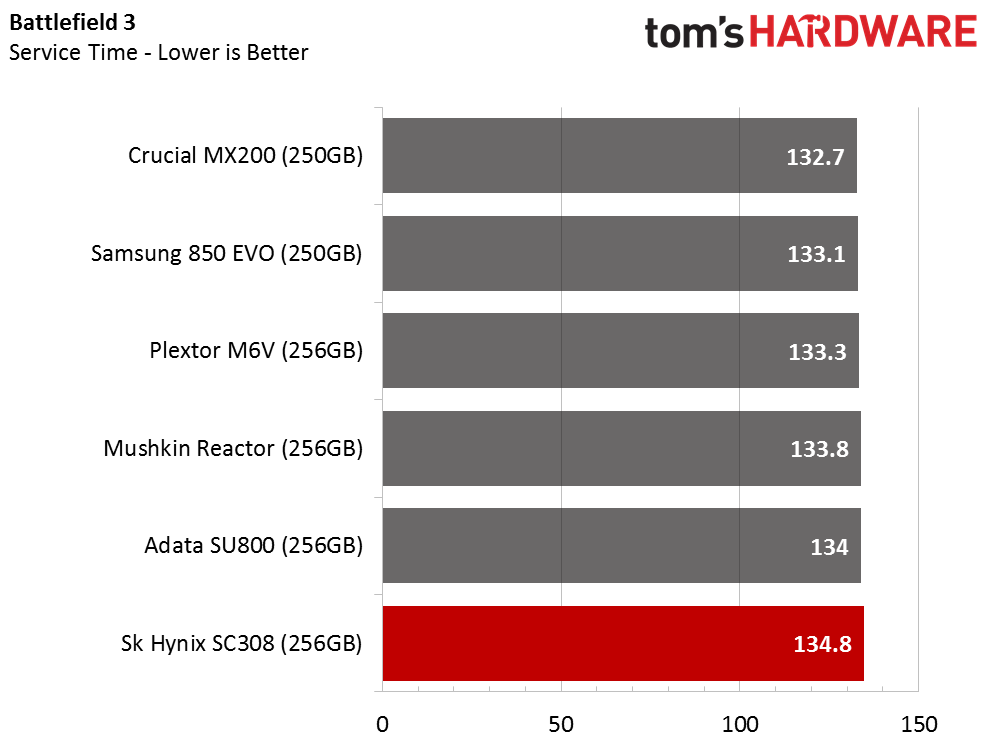
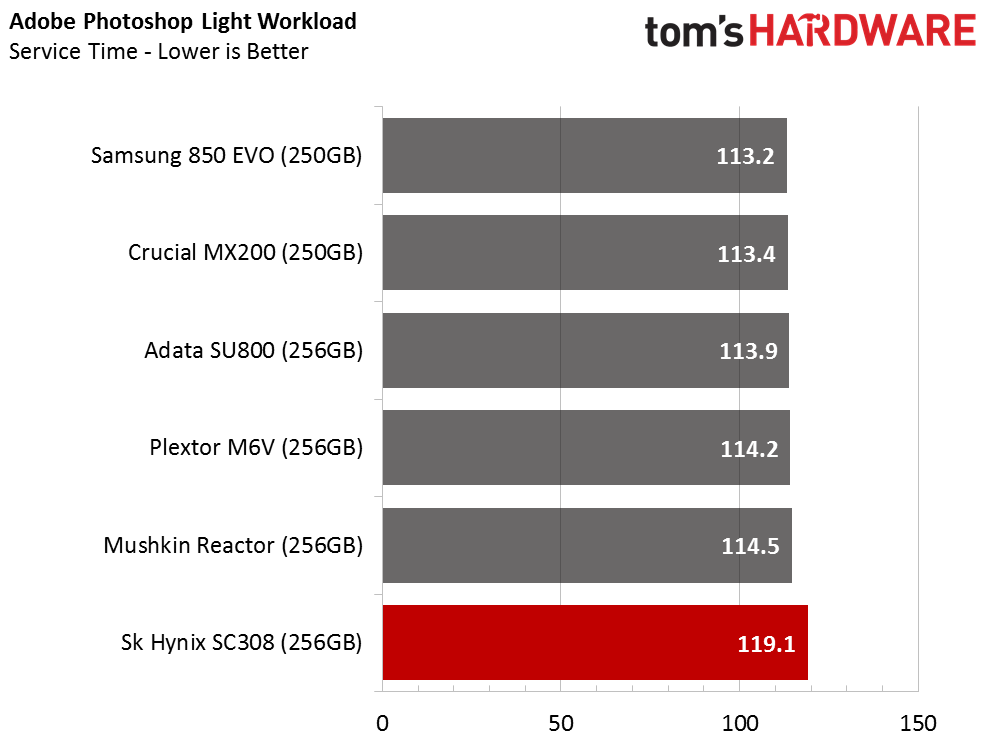
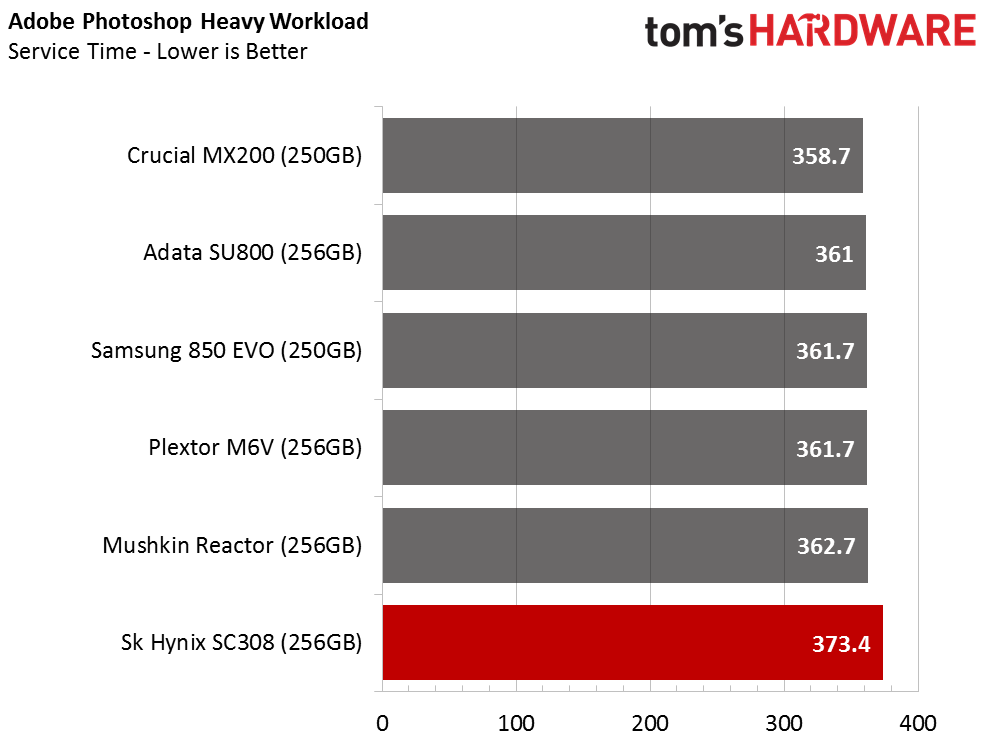
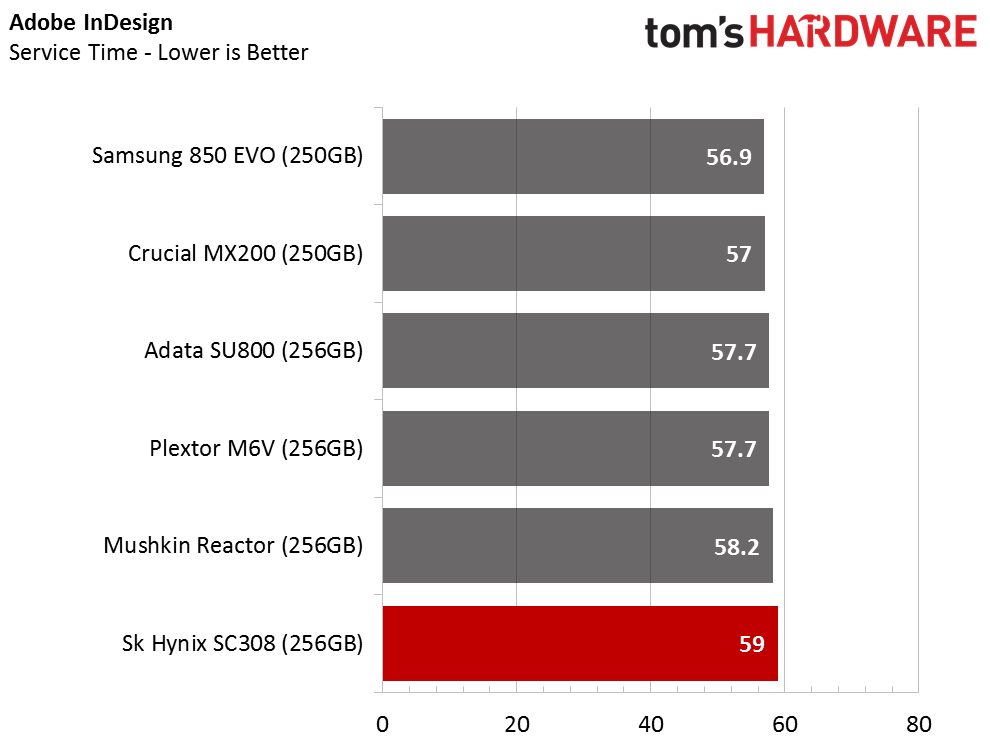
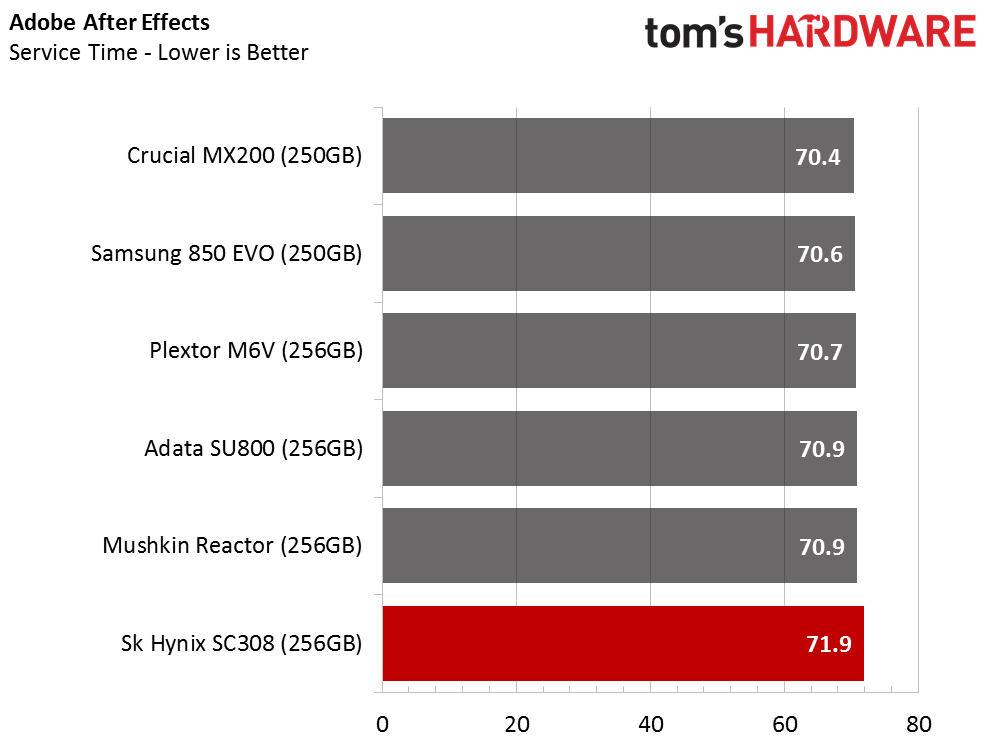
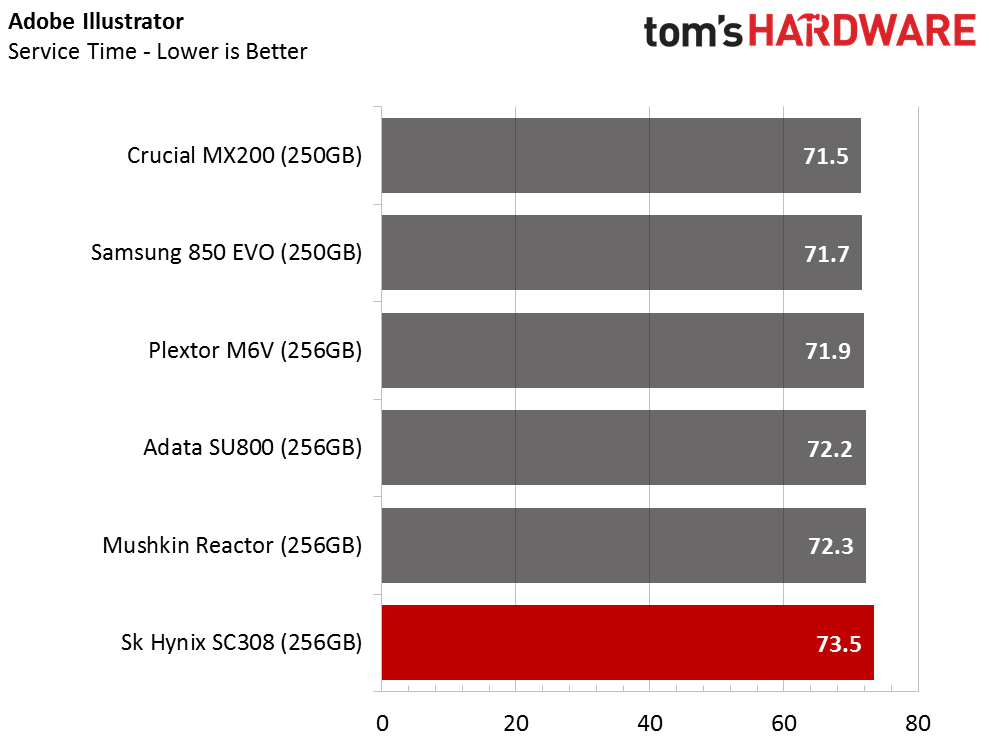
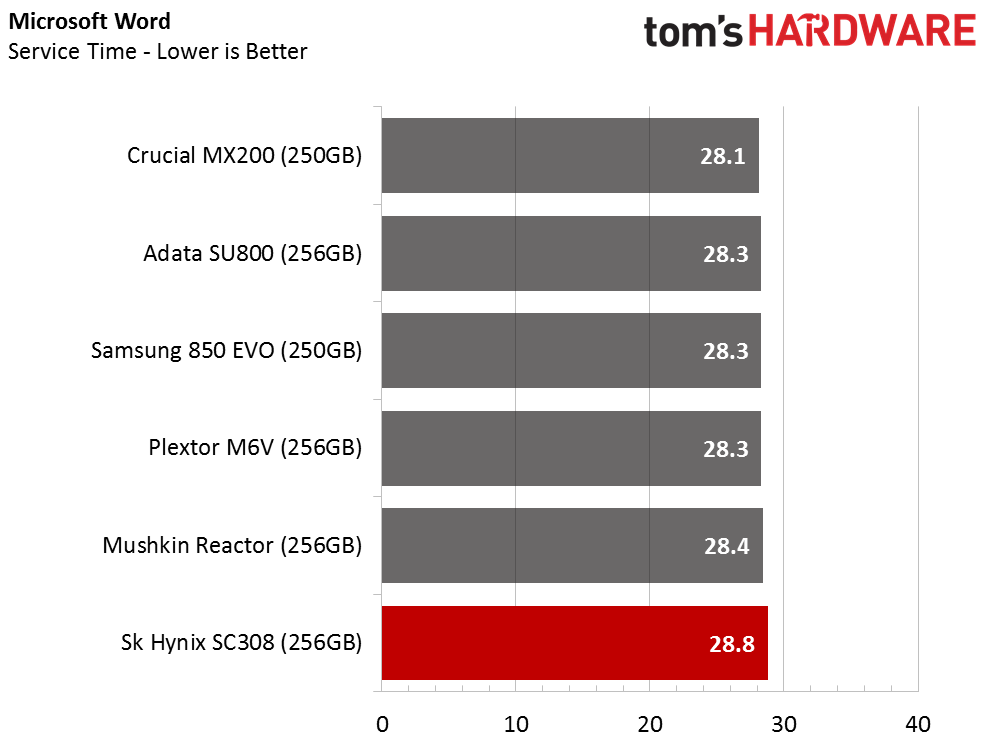
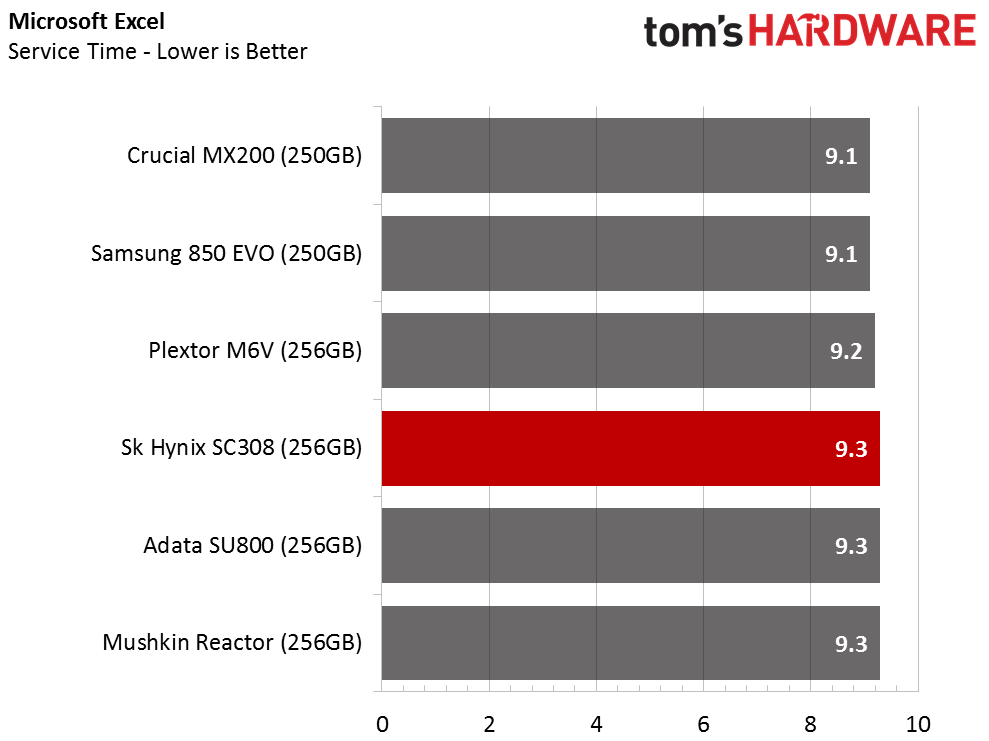
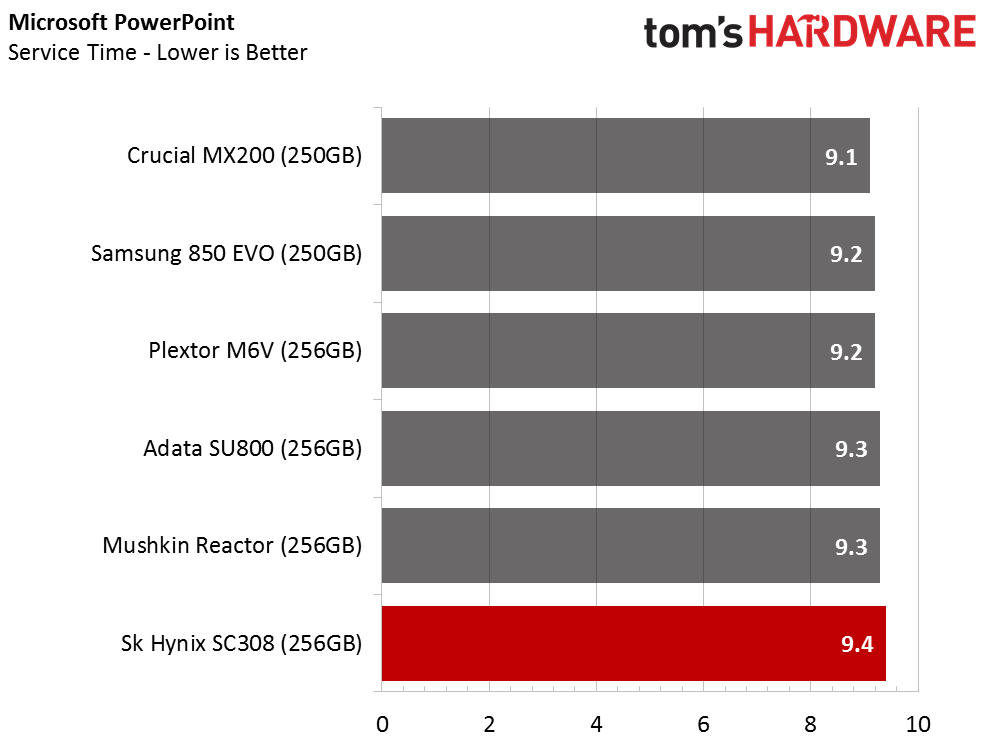
The low mixed random performance will have an adverse impact on the user experience during normal desktop use. An SLC buffer would certainly help to increase performance, but it’s too late to add that to the SC308 design.
Application Storage Bandwidth
The low performance is more obvious when we average the results and present them as throughput data. The SK Hynix SC308 falls to the bottom of the chart.
PCMark 8 Advanced Workload Performance
To learn how we test advanced workload performance, please click here.
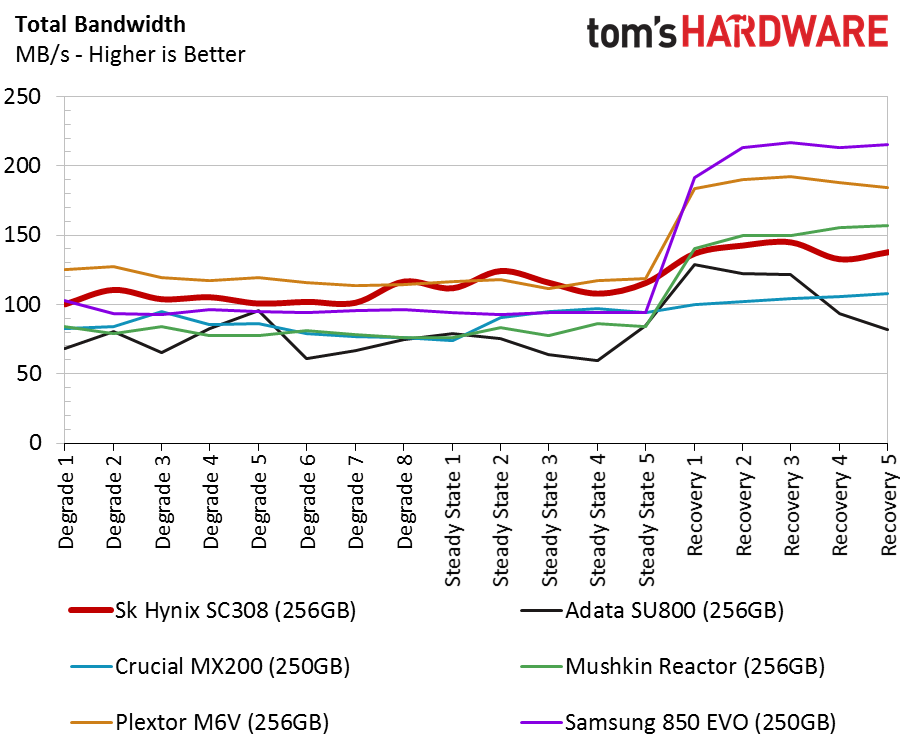
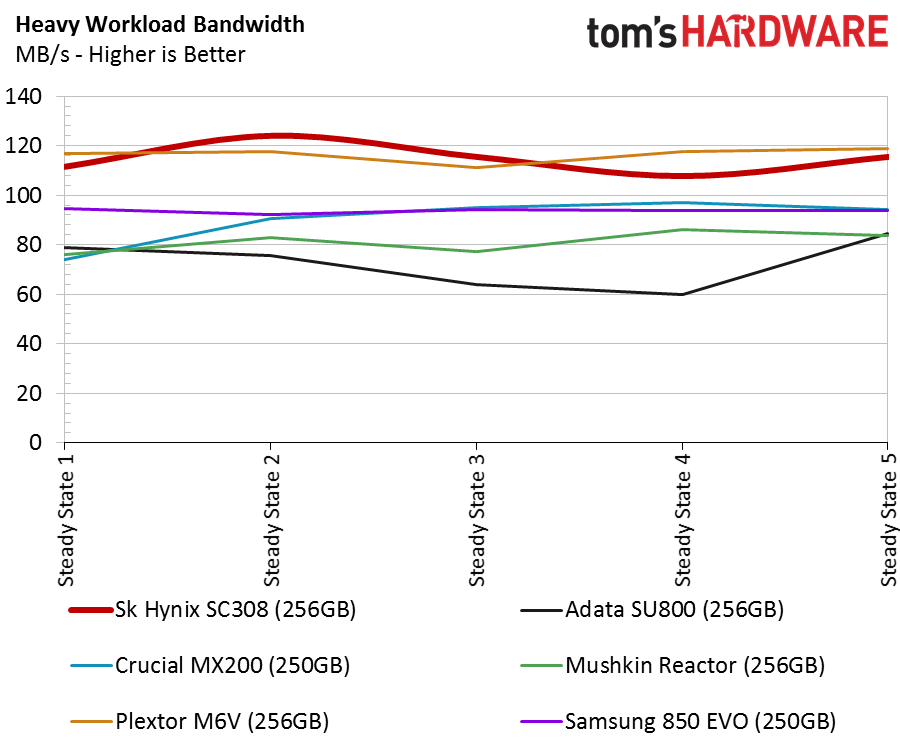

Like the larger drive, the SC308 256GB is better during heavy workloads.
Total Service Time
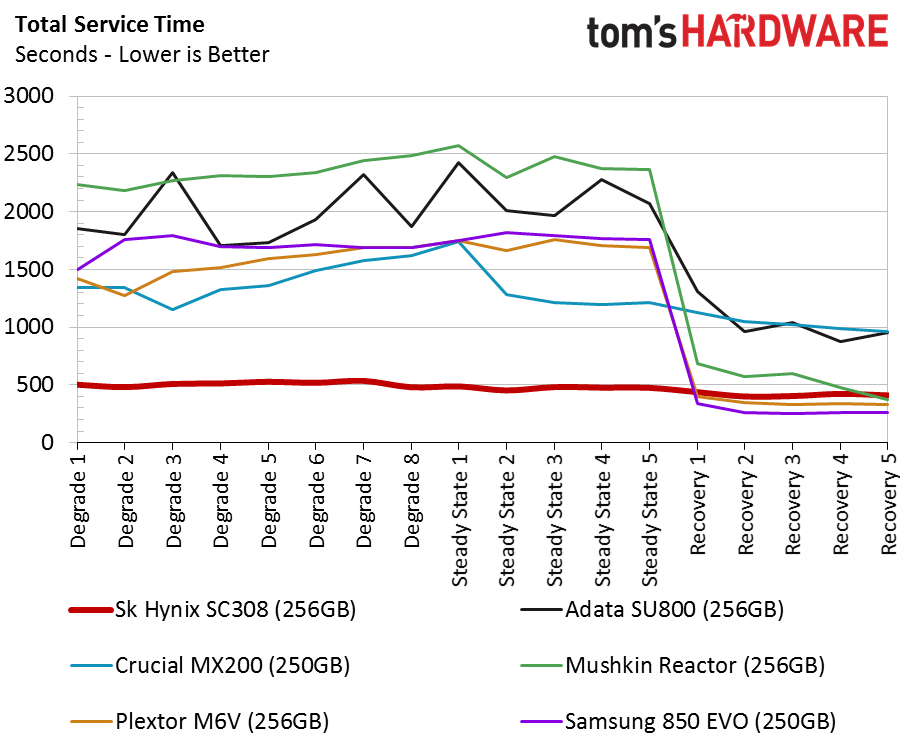
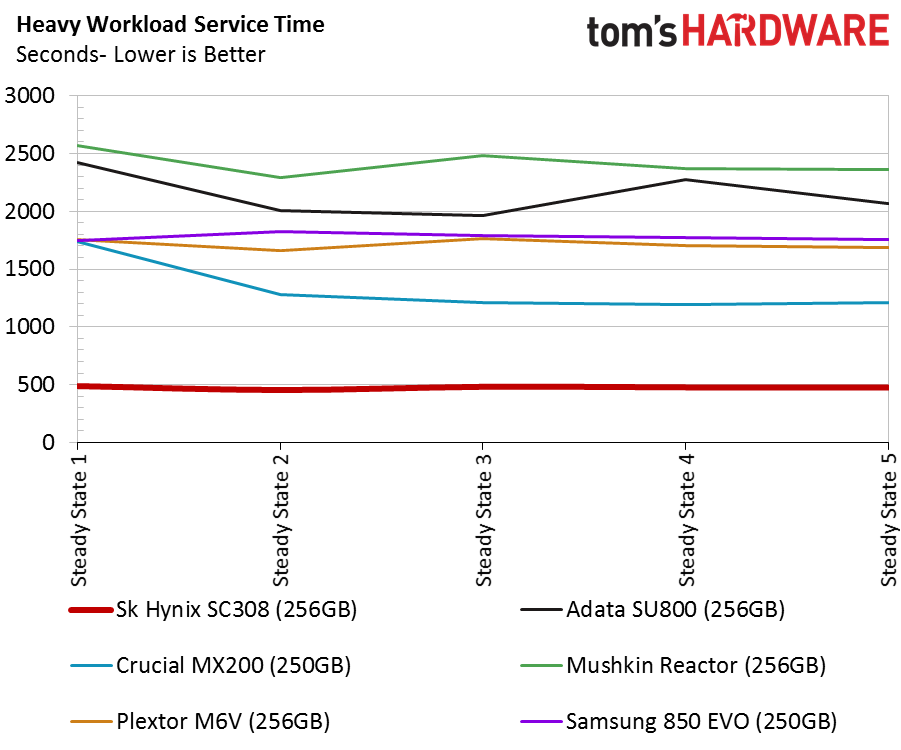
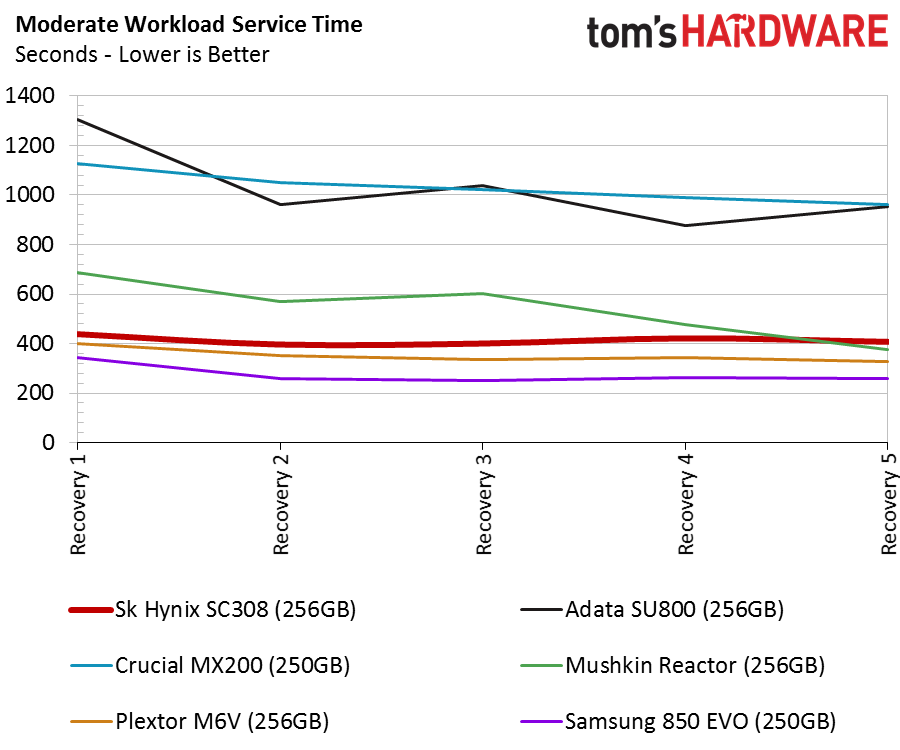
The 256GB SC308 is more competitive than the 512GB model. It's disheartening to see the SC308 suffer from lackluster performance in light- and moderate-use scenarios, particularly because it does so well under heavy use. It's a lot like the Samsung 850 Pro.
Disk Busy Time
We can often tell how an SSD will handle the Notebook Battery Life test by examining the disk busy time. As you will see, that isn't the case with the SC308.
Notebook Battery Life
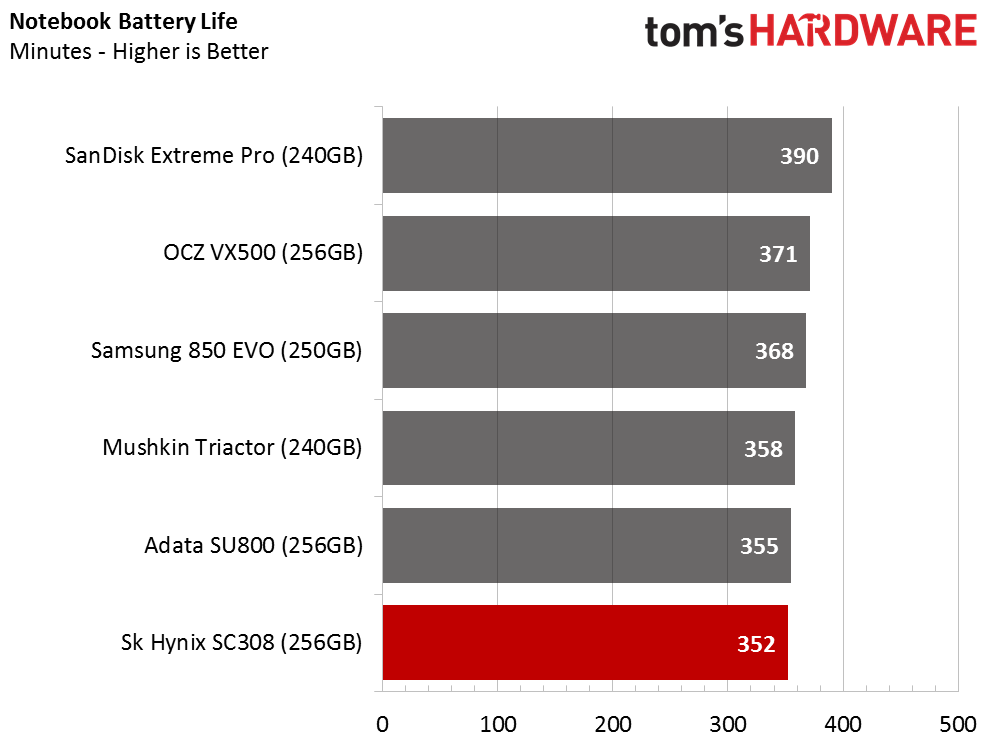
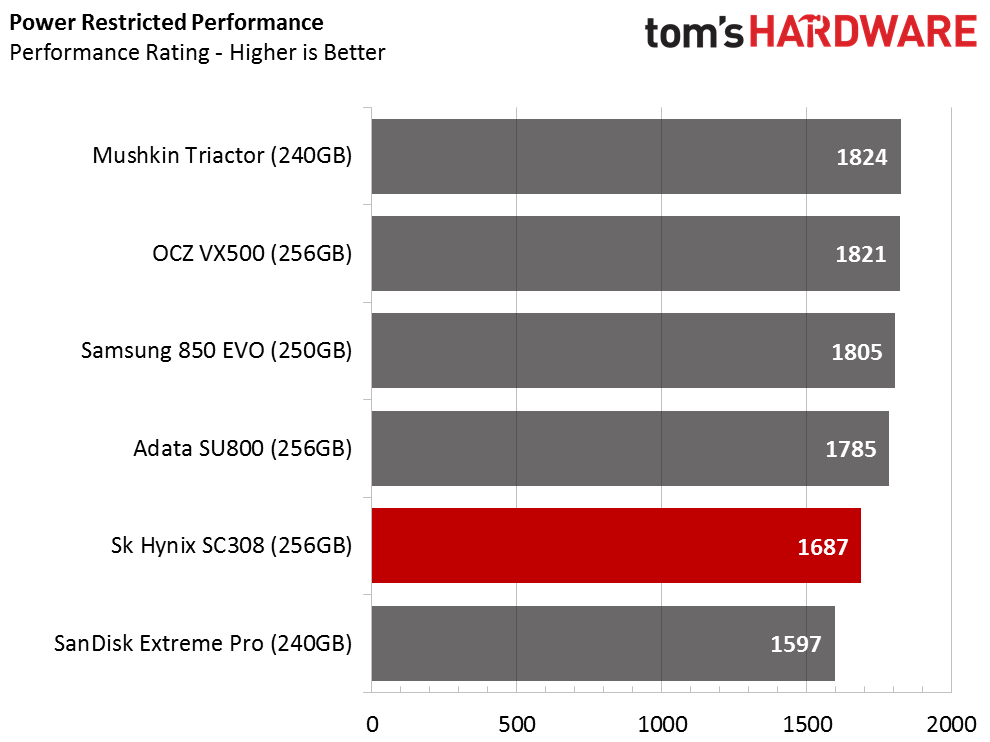
The SK Hynix SC308 256GB consumes more power than the other SSDs. We observed this behavior with both capacities, but can't explain why. The drives still deliver longer battery time than a hard disk drive, but they don't meet the same high standards set by other flash-based products.
MORE: Best SSDs
MORE: How We Test HDDs And SSDs
MORE: All SSD Content
Current page: 256GB Performance Testing
Prev Page 512GB Performance Testing Next Page Final Thoughts
Chris Ramseyer was a senior contributing editor for Tom's Hardware. He tested and reviewed consumer storage.
-
eyupo92 The interface/protocol entry 'NVMe 1.2' on the specifications table is wrong - I have testing 128 GB 2.5" and 256 GB m.2 versions, and they are SATA 6 Gbps. In the article you are already mentioning it as SATA, so fixing the table would solve this small issue.Reply -
mapesdhs $130 for the MX300? I wish; it's more like $195 equivalent here (UK). Strangely, the disparity vs. the 850 EVO is less severe, it's priced the same as the MX300, with the SL308 a bit below that. No sign yet of the SC308 from normal sources.Reply -
alextheblue I applaud the use of MLC, but without a really good controller, it's kind of a waste. For most users, older SATA systems upgrading to an SSD will still be better served with an 850 Evo or similar. It's better in typical end-user scenarios, they don't need the heavy workload and sustained performance as much as they need the light workload / burst speed. I would especially point to the random mixed workload (80% reads) - I feel that sort of test is fairly good at highlighting the differences in performance for the average user's workload.Reply
I find it kind of sad there isn't really anything that fully dethrones the 850 Evo on performance/value in the SATA world. It's been what, 2.5 years? Longer? There's still a lot of older systems with plenty of CPU horsepower, for which an SSD upgrade from a mechanical drive would vastly improve user experience. -
cryoburner ReplyThe low mixed workload performance really hurts the user experience, and that shows in the PCMark 8 Storage test.
...Tom's claims, immediately after posting a bunch of "Real-World Software Performance" charts that show all the drives performing very similar to one another. In what way does it "really hurt the user experience" when there's only around a 2% difference in application performance between the drives? Is anyone even going to subjectively distinguish such a difference? If it takes an extra 2 seconds to complete a 2 minute task, how much does that even really matter? Is it worth paying 20% more for another drive just to get 2% better performance in real-world tasks? -
derekullo Ooo I recognize this as the ssd in the Dell 7440s we just bought at work (256 gigabytes).Reply
When your sequential read is basically the limit of SATA and you are pushing 9000 -12000 iops at a queue depth of 1 - 2 the bottleneck is no longer the storage device, it's the storage interface, SATA.
Having said that the only way to really compete is:
1. Battery Life (40 minutes is noticeable between this drive and the Samsung)
2. IOPS at a queue depth of 1 - 4 (Basically so you can put a higher number on the packaging)
3. Write Speed
I use a Patriot Memory 256GB Supersonic Magnum 2 with the Windows 7 Bootable install and I'm able to install a fresh Windows 7 in about 10 minutes on a computer with this ssd.
Windows update is blazingly fast.
I use this combination to create WIM images that I capture for use on other computers.
The read speed of the flash drive, 400 MB/s, is faster than the write speed of the Sk Hynix 261 MB/s.
I would have rathered a Samsung 960 Pro or even a Samsung 850 Evo, but I'm just glad Dell didn't give us an ADATA ... (with that write speed 62 MB/s)
We've had Sata 3.0 since 2009.
Hopefully we can see some SATA 3.2 motherboards / ssd releasing soon.
https://en.wikipedia.org/wiki/Serial_ATA#SATA_revision_3.2_.2816.C2.A0Gbit.2Fs.2C_1969.C2.A0MB.2Fs.29
NVME / m.2 is faster but you are limited in the amount of drives that can be attached to the motherboard. -
HERETIC-1 Hi Chris,Reply
Agree application bandwidth is a little sad.
Thro 500 is probably the most common size for a lappy,I think 250 is
common in desktops as a boot drive-on that note is there any chance
of a review on MX300-275GB-seems to be a very popular drive-also the
WD 250 blue would be nice as well..............................
Keep up the good work............. -
AgentLozen I hate how TLC flash is ruining the solid state drive market. Whenever it's used, the outcome is ALWAYS horrendous. I can't think of a single SSD from within the last 3 years that uses TLC and is even remotely well regarded.Reply
If you're smart like me then you'll stick with the good ol' Intel x25-m. I've got two in RAID 0 in my system at home and I have a few more sitting off to the side in case anything ever goes wrong with them. If you're not familiar with the Intel x25-m, that's because they came out before TLC reared it's ugly head. The x25-m has no competition even today because it's outfitted with MLC flash. Some people say that NVMe M.2 drives are the future, but they can't compete with my Intel drives because they are outfitted with MLC.
If you guys wanna talk about how cool MLC flash is please PM me. Don't waste my time with TLC though. You might as well be making punch cards and destroying them immediately after if you want the speed and endurance of TLC.
(If it wasn't clear, I'm being facetious. TLC is perfectly fine for home desktop use. There are plenty of drives like the Samsung 850 and 960 EVO that demonstrate that TLC is a fundamentally sound technology. Please don't PM me gushing about MLC flash. thx) -
CRamseyer Reply19898964 said:The low mixed workload performance really hurts the user experience, and that shows in the PCMark 8 Storage test.
...Tom's claims, immediately after posting a bunch of "Real-World Software Performance" charts that show all the drives performing very similar to one another. In what way does it "really hurt the user experience" when there's only around a 2% difference in application performance between the drives? Is anyone even going to subjectively distinguish such a difference? If it takes an extra 2 seconds to complete a 2 minute task, how much does that even really matter? Is it worth paying 20% more for another drive just to get 2% better performance in real-world tasks?
There is a difference between throughput and latency.
